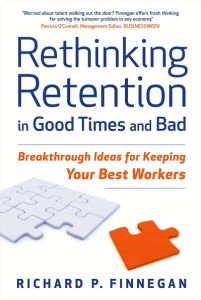加入 getAbstract 阅读摘要

加入 getAbstract 阅读摘要
Richard P. Finnegan
Rethinking Retention in Good Times and Bad
Breakthrough Ideas for Keeping Your Best Workers
Davies-Black Publishing, 2009
看看什么内容?
Even organizations that slash jobs cannot afford to lose their best employees. Here’s how to hold on to them.
Recommendation
You might think that a recession is exactly the time when good employees batten down their hatches and cling to their jobs, even if they do not like them. Think again. Really talented employees can find work during any economic period. Indeed, they change jobs all the time. Such turnover cuts productivity, making operations less efficient, and burdens companies with heavy employee replacement costs. Although the tariff can be staggering, most organizations do not have a formal – or even an informal – turnover abatement process. Instead, they relegate retention to a sideline human resources department activity. To correct this operational oversight, retention consultant Richard P. Finnegan provides the “Rethinking Retention Model,” a robust best-practices program you can use to cut down on expensive employee churn. In his heavily researched and sourced book, Finnegan thoroughly details the exact steps organizations should implement to increase retention. He offers numerous case studies that illustrate how companies hold on to their best employees. getAbstract highly recommends this comprehensive, logical, thoughtful guide as an ideal resource for CEOs, managers and HR executives who need to close the revolving door.
Summary
About the Author
Richard P. Finnegan heads Finnegan Mackenzie, a retention consultancy. His articles on employee retention routinely appear in the business and professional media.

















Comment on this summary